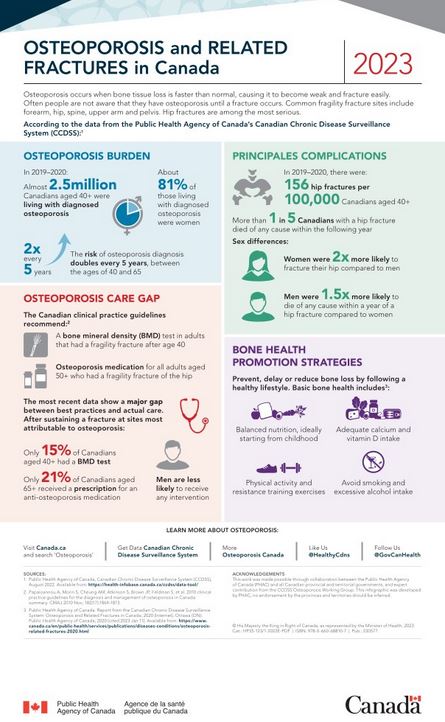Osteoporosis and related fractures in Canada, 2023
Download in PDF format
(244 KB, 1 page)
Organization: Public Health Agency of Canada
Published: February 2024
ISBN: 978-0-660-68810-7
Cat.: HP35-123/1-2023E-PDF
Pub.: 230577
Tell us what you think
Help us improve our products, answer our quick survey.
Osteoporosis occurs when bone tissue loss is faster than normal, causing it to become weak and fracture easily. Often people are not aware that they have osteoporosis until a fracture occurs. Common fragility fracture sites include forearm, hip, spine, upper arm and pelvis. Hip fractures are among the most serious.
According to the data from the Public Health Agency of Canada's Canadian Chronic Disease Surveillance System (CCDSS): Footnote 1
Osteoporosis burden
In 2019–2020:
- Almost 2.5 million Canadians aged 40+ were living with diagnosed osteoporosis
- About 81% of those living with diagnosed osteoporosis were women
- The risk of osteoporosis diagnosis doubles every 5 years, between the ages of 40 and 65
Osteoporosis care gap
The Canadian clinical practice guidelines recommend: Footnote 2
- A bone mineral density (BMD) test in adults that had a fragility fracture after age 40
- Osteoporosis medication for all adults aged 50+ who had a fragility fracture of the hip
The most recent data show a major gap between best practices and actual care. After sustaining a fracture at sites most attributable to osteoporosis:
- Only 21% of Canadians aged 65+ received a prescription for an anti-osteoporosis medication
- Only 15% of Canadians aged 40+ had a BMD test
- Men are less likely to receive any intervention
Primary complications
In 2019–2020, there were:
- 156 hip fractures per 100,000 Canadians aged 40+
- More than 1 in 5 Canadians with a hip fracture died of any cause within the following year
Sex differences:
- Women were 2 times more likely to fracture their hip compared to men
- Men were 1.5 times more likely to die of any cause within a year of a hip fracture compared to women
Bone health promotion strategies
Prevent, delay or reduce bone loss by following a healthy lifestyle. Basic bone health includes: Footnote 3
- Balanced nutrition, ideally starting from childhood
- Adequate calcium and vitamin D intake
- Physical activity and resistance training exercises
- Avoid smoking and excessive alcohol intake
Learn more about osteoporosis:
Visit Canada.ca and search 'Osteoporosis'
Get Data Canadian Chronic Disease Surveillance System
More Osteoporosis Canada
Like Us @HealthyCdns
Follow Us @GovCanHealth
Sources:
- Footnote 1
-
Public Health Agency of Canada, Canadian Chronic Disease Surveillance System (CCDSS), August 2022. Available from: https://health-infobase.canada.ca/ccdss/data-tool/.
- Footnote 2
-
Papaioannou A, Morin S, Cheung AM, Atkinson S, Brown JP, Feldman S, et al. 2010 clinical practice guidelines for the diagnosis and management of osteoporosis in Canada: summary. CMAJ 2010 Nov; 182(17):1864-1873.
- Footnote 3
-
Public Health Agency of Canada. Report from the Canadian Chronic Disease Surveillance System: Osteoporosis and Related Fractures in Canada, 2020 [Internet]. Ottawa (ON): Public Health Agency of Canada; 2020 [cited 2023 Jan 11]. Available from: https://www.canada.ca/en/public-health/services/publications/diseases-conditions/osteoporosis-related-fractures-2020.html.
